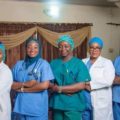Definition
Rehabilitation is a treatment or treatment designed to facilitate the process of recovery from injury, illness, or disease to as normal a condition as possible.
Purpose
The purpose of rehabilitation is to restore some or all of the patient’s physical, sensory, and mental capabilities that were lost due to injury, illness, or disease. Rehabilitation includes assisting the patient to compensate for deficits that cannot be reversed medically. It is prescribed after many types of injury, illness, or disease, including amputations, arthritis, cancer, cardiac disease, neurological problems, orthopedic injuries, spinal cord injuries, stroke, and traumatic brain injuries. The Institute of Medicine has estimated that as many as 14% of all Americans may be disabled at any given time.
Precautions
Rehabilitation should be carried out only by qualified therapists. Exercises and other physical interventions must take into account the patient’s deficit. An example of a deficit is the loss of a limb.
Description
A proper and adequate rehabilitation program can reverse many disabling conditions or can help patients cope with deficits that cannot be reversed by medical care. Rehabilitation addresses the patient’s physical, psychological, and environmental needs. It is achieved by restoring the patient’s physical functions and/or modifying the patient’s physical and social environment. The main types of rehabilitation are physical, occupational, and speech therapy.
Each rehabilitation program is tailored to the individual patient’s needs and can include one or more types of therapy. The patient’s physician usually coordinates the efforts of the rehabilitation team, which can include physical, occupational, speech, or other therapists; nurses; engineers; physiatrists (physical medicine); psychologists; orthotists (makes devices such as braces to straighten out curved or poorly shaped bones); prosthetists (a therapist who makes artificial limbs or protheses); and vocational counselors. Family members are often actively involved in the patient’s rehabilitation program.
Physical therapy
Physical therapy helps the patient restore the use of muscles, bones, and the nervous system through the use of heat, cold, massage, whirlpool baths, ultrasound, exercise, and other techniques. It seeks to relieve pain, improve strength and mobility, and train the patient to perform important everyday tasks. Physical therapy may be prescribed to rehabilitate a patient after amputations, arthritis, burns, cancer, cardiac disease, cervical and lumbar dysfunction, neurological problems, orthopedic injuries, pulmonary disease, spinal cord injuries, stroke, traumatic brain injuries, and other injuries/illnesses. The duration of the physical therapy program varies depending on the injury/illness being treated and the patient’s response to therapy.
Exercise is the most widely used and best-known type of physical therapy. Depending on the patient’s condition, exercises may be performed by the patient alone or with the therapist’s help, or with the therapist moving the patient’s limbs. Exercise equipment for physical therapy could include an exercise table or mat, a stationary bicycle, walking aids, a wheelchair, practice stairs, parallel bars, and pulleys and weights.
Heat treatment, applied with hot-water compresses, infrared lamps, short-wave radiation, high-frequency electrical current, ultrasound, paraffin wax, or warm baths, is used to stimulate the patient’s circulation, relax muscles, and relieve pain. Cold treatment is applied with ice packs or cold-water soaking. Soaking in a whirlpool can ease muscle spasm pain and help strengthen movements. Massage aids circulation, helps the patient relax, relieves pain and muscle spasms, and reduces swelling. Very low-strength electrical currents applied through the skin stimulate muscles and make them contract, helping paralyzed or weakened muscles respond again.
Occupational therapy
Occupational therapy helps the patient regain the ability to do normal everyday tasks. This may be achieved by restoring old skills or teaching the patient new skills to adjust to disabilities through adaptive equipment, orthotics, and modification of the patient’s home environment. Occupational therapy may be prescribed to rehabilitate a patient after amputation, arthritis, cancer, cardiac disease, head injuries, neurological injuries, orthopedic injuries, pulmonary disease, spinal cord disease, stroke, and other injuries/illnesses. The duration of the occupational therapy program varies depending on the injury/illness being treated and the patient’s response to therapy.
Occupational therapy includes learning how to use devices to assist in walking (artificial limbs, canes, crutches, walkers), getting around without walking (wheelchairs or motorized scooters), or moving from one spot to another (boards, lifts, and bars). The therapist will visit the patient’s home and analyze what the patient can and cannot do. Suggestions on modifications to the home, such as rearranging furniture or adding a wheelchair ramp, will be made. Health aids to bathing and grooming could also be recommended.
Speech therapy
Speech therapy helps the patient correct speech disorders or restore speech. Speech therapy may be prescribed to rehabilitate a patient after a brain injury, cancer, neuromuscular diseases, stroke, and other injuries/illnesses. The duration of the speech therapy program varies depending on the injury/illness being treated and the patient’s response to therapy.
Performed by a speech pathologist, speech therapy involves regular meetings with the therapist in an individual or group setting and home exercises. To strengthen muscles, the patient might be asked to say words, smile, close his mouth, or stick out his tongue. Picture cards may be used to help the patient remember everyday objects and increase his vocabulary. The patient might use picture boards of everyday activities or objects to communicate with others. Workbooks might be used to help the patient recall the names of objects and practice reading, writing, and listening. Computer programs are available to help sharpen speech, reading, recall, and listening skills.
Other types of therapists
Inhalation therapists, audiologists, and registered dietitians are other types of therapists. Inhalation therapists help the patient learn to use respirators and other breathing aids to restore or support breathing. Audiologists help diagnose the patient’s hearing loss and recommend solutions. Dietitians provide dietary advice to help the patient recover from or avoid specific problems or diseases.
Rehabiltation centers
Rehabilitation services are provided in a variety of settings including clinical and office practices, hospitals, skilled-care nursing homes, sports medicine clinics, and some health maintenance organizations. Some therapists make home visits. Advice on choosing the appropriate type of therapy and therapist is provided by the patient’s medical team.
History of Medical Rehabilitation Therapy in Nigeria
The unique milestone in the eventful history of the world of Medical Rehabilitation on the continent of Africa was made on Tuesday, December 29, 1992, when the then Honourable Minister of Health, Late Professor Olikoye Ransome-Kuti inaugurated the Medical Rehabilitation Therapists (Registration) Board of Nigeria. The struggle for a legal regulating Board of control for the various medical disciplines in Medical Rehabilitation Therapy in Nigeria was a long and tedious one, dating as far back as 1959 when the Nigeria Society of Physiotherapy (NSP) was established. At long last, the Medical Rehabilitation Therapists (Registration) Board of Nigeria was constituted by a Nigerian Law, i. e. Decree 38 of 1988/M9 LFN 2004.
The Board, MRTB, is a Parastatal, and an arm of the Federal Ministry of Health. Unlike other Boards/Councils; the Medical Rehabilitation Therapists (Registration) Board of Nigeria has a heterogeneous nature in the sense that the Board controls the training and practice of six (6) different Medical Professions in the Health Sector in Nigeria, namely:
- Physiotherapy
Physiotherapy is a dynamic and autonomous profession characterized by a body of knowledge with an established theoretical base and widespread clinical applications in the examination/assessment, treatment, and rehabilitation of Neuro-musculoskeletal, cardiovascular, integumentary, and respiratory disorders with the aim of preserving, developing, and restoring physical functions by natural methods. Physical Therapy was initiated by a few expatriate Physiotherapists in National Orthopaedic Hospital, Igbobi as Technicians in 1945. From Igbobi, Lagos, it then extended to other centers like Ibadan, Kano, and Enugu. The major components of Physiotherapy, are Diagnostic, curative, therapeutic, preventive, and Rehabilitative Physiotherapy. The profession aimed at restoring the patient to a level where he is able to achieve maximum potential for normal living in the Physical, Psychological, Social, and Vocational senses. It accounts for over 90% of the Board’s (MRTB’s) registrants and is clinically practiced today in diverse settings, industries, schools, colleges, rehabilitation centers, and homes for the elderly. The Board presently has about two thousand (2000) qualified Physiotherapists and sixty – three (63) Physiotherapy. Technicians practicing in the country and diaspora.
- Occupational Therapy
Occupational Therapy, an important aspect of Medical Rehabilitation, involves the utilization of constructive and manipulative activities as media for therapy with emphasis on the use of occupation to close the gap between disability and ability. Essentially, Occupational Therapy is about rehabilitating patients back into the community or society with an applicable level of self-reliance that will enable them to perform their ability. Without occupational therapy, there would be a missing link in the recovery process. It views all human beings as an occupational being in a way to adapt all activities within the influence of the environment relying mainly on the individual’s choices of roles and tasks that a person possibly enjoys doing and is within her motivational level of performance. The practice was initiated by a few expatriates in the early fifties at the Psychiatric hospitals in Lagos and Abeokuta, Ogun State, and later at the University College Hospital, Ibadan, Oyo State. Nigerians started training as Occupational Therapists in the late 1950s and a large percentage were trained in Britain. During the Civil war, Civilian Occupational Therapists were co-opted to serve in the army as non-commissioned officers. Occupational Therapy ranks second (2nd) to Physiotherapy in terms of population of Registrants. Currently, the Board can boast of twenty–nine (29) qualified and registered Occupational. Therapists and eighty-six (86) Technicians practicing in Nigeria in Teaching, Psychiatric, Orthopaedic hospitals, army resettlement centers, social development ministry, etc.
- Chiropractic and Osteopathic Medicine
Chiropractic medicine is an aspect of medicine relating to spinal column adjustment and other rotations of parts of a body, to align the parts back into their proper positions. While osteopathic is an essential approach to medicine focusing on the bones and muscles and their relationship to diseases and pathology. Both professions are essential components of Rehabilitation. The Board has only four (4) licensed Chiropractors and two (2) Osteopaths in her register.
- Speech Therapy / Audiology
This is a branch of Medical Rehabilitation Therapy aimed at maximizing essential skills concerned with language ability in those people born with a mental or physical handicap or in those who have lost these skills because of disease or trauma. Audiology, on the other hand, is the scientific study of hearing aimed at restoring patients with hearing deficits to as near normal as possible taking into consideration the limitation set-up by the pathology. Hearing assessment, detecting hearing impairment, dispensing and fitting of hearing aids, providing counseling, and monitoring hearing-impaired are few of their professional duties. The Board (MRTB) has fifty (50) Speech Therapists/Audiologists registered with it. Presently the profession does not have a low-level cadre (Technicians).
- Prosthetics and Orthotics
Prosthetics and Orthotics which is the evaluation, fabrication and custom-fitting of artificial limbs and orthopedic braces are also regulated and controlled by the Board (MRTB). They joined the league of professions controlled by the Board a couple of years ago and MRTB can boast of seven (7) of these professionals working in diverse settings in the country. As part of Medical Rehabilitation Therapy, professionals are also involved in preventing/correcting the consequences of the disease impairment, disability, and handicap and where possible eliminating the consequent handicaps.
In the year 2000, the Chiropractors and Osteopaths migrated into another Board/Council, leaving the Board, MRTB, with the responsibility of regulating and controlling the training and practice of Physiotherapy, Occupational Therapy, Speech Therapy, and Clinical Audiology in the Health Sector in Nigeria.
In compliance with the law, every practitioner of any of the above professions in Nigeria is expected, at the beginning of every year to renew his or her professional practicing license to enable him/her to legally practice his/her profession and apply for medical rehabilitation jobs in Nigeria.






